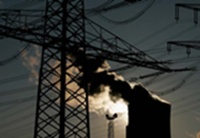 In a clear indication of an economic revival, the demand for power in India has jumped 6.3 per cent in the April-October period this financial year, compared with the same period of 2007-08 when it had increased by a mere 0.3 per cent, its lowest growth in the past five years, owing to the global financial meltdown.
In a clear indication of an economic revival, the demand for power in India has jumped 6.3 per cent in the April-October period this financial year, compared with the same period of 2007-08 when it had increased by a mere 0.3 per cent, its lowest growth in the past five years, owing to the global financial meltdown.
According to the latest data obtained from the Central Electricity Authority, while power demand increased marginally from 108,911 Mw in the first seven months of the financial year 2007-08 to 109,304 Mw in the same period of 2008-09, it jumped to 116,281 Mw in the first seven months of 2009-10, as industrial activity improved due to the recovery. Factories accounted for around 30-40 per cent of the total power consumed in the country.
The latest figures of the Index of Industrial Production released last week, where power carries a weight of around 10.17 per cent, also point to this recovery in demand. The power sector has grown at a rate of 6.8 per cent between Aril and October this year, compared with 2.5 per cent in the same period a year ago.
Power is one of the six major sectors contributing to the country's infrastructure in addition to cement, steel, coal, crude oil and petroleum products. The growth of these sectors account for more than a quarter in the IIP.
This rising demand has, however, failed to have a negative impact on the power deficit front, owing to improved availability of power, primarily due to the availability of K-G basin gas which started flowing in April and the resuming of hydro generation.
Peak power deficit fell to 12.6 per cent in the seven-month period ended October this year from 13.5 per cent in the corresponding period in the last financial year, as availability registered a historic five-fold jump to 101,609 Mw in April-October 2009, according to CEA data.
However, while applauding the government's effort in meeting the short-term electricity demand, the Indian industry believes power could become a constraint in case the vast capacities in the pipeline do not materialise.
"As availability of power too has gone up significantly this year, it is enough to take care of the immediate demand. But there is a capacity of over 25,000 Mw still in the pipeline, including 16,000 Mw from the four upcoming ultra-mega power projects. If this capacity is not materialised, power could become a constraint in achieving the 9 per cent growth target," said Amit Mitra, secretary-general, Federation of Indian Chambers of Commerce and Industry, who is also a member of the power ministry's advisory council.
He also added that India should aim at generating at least 200 per cent of its overall requirement of electricity, if it has to meet its future power demand.
Experts believe the higher demand for electricity will impact power prices too.
"The price of power will remain strong in case the demand continues to be high, as no significant supply increase is expected in the near future. There is a strong correlation between GDP growth and power demand," said Kuljit Singh, head of Transaction Advisory Services at Ernst & Young. Every 1 per cent increase in GDP results in an increase of about 0.9 per cent in the demand for power, according to experts.
Earlier this week, the economic think-tank Centre for Monitoring Indian Economy had revised upwards its GDP growth projections for the current financial year to 6.2 per cent from an earlier estimate of 6 per cent on the back of a faster-than-expected recovery. Financial services major DSP Merill Lynch too raised its projections from 5.8 per cent to 6.2 per cent GDP growth this fiscal.
Singh, however, also added that in the short-term the increased power demand could deter investors by increasing the risk of regulatory intervention in trading market.
"Though, in the long-term, the higher prices are likely to attract generators to set up new capacities," he said.
The power ministry has estimated that for maintaining an 8 per cent GDP growth rate, the electricity demand will have to increase to 859 billion units by the end of the current Plan period ended 2012. A 7 per cent GDP growth rate will still require about 820 billion units of electricity. India's current power demand stands at around 770 billion units, against which it is able to generate only around 690 billion units of power annually.
If its economy grows at 7 per cent, India will still need to add over 52,000 Mw of power generation capacity by 2012. The country plans to add 78,000 Mw capacity in the current Plan period. This capacity addition target is planned for a GDP growth of over 8 per cent. Around 23 per cent of this target has been achieved, so far.





